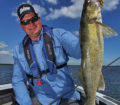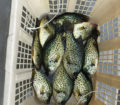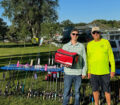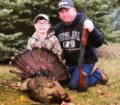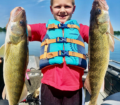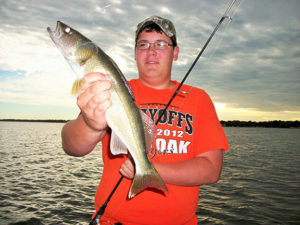 By Doug Burns
By Doug Burns
In the spring time, before any weed growth arrives, most of the walleye in Spirit Lake in NW Iowa spend the daytime hours on deep transitions at the edge of the lake’s muddy basin, or cruising the basin itself. During the day these fish feed sparingly on shiners and perch. After the sun sets walleye pursue shiners into the shallows and feed heavily. As the days lengthen and the water warms weeds begin to develop, beckoning the shiners and perch to move shallow. It’s in these shallows the perch and shiners will spawn. Since the food has moved shallow, the walleye follow. The walleye exodus from deep water to shallow doesn’t happen all at once. Instead a few fish that move in each night simply stop moving back to deep water during the day. More of the population stays shallow each day as they begin cruising the flats and setting up shop in the new weed growth.
At first the weeds are sparse and scattered with some patches growing much quicker than others. This spreads the prey and predators out. Covering water with live bait rigs, mainly spinners tipped with crawlers or leeches, is the standard for catching these fish. Slow Death hooks are sometimes a better option or maybe the simplest of rigs, the plain hook with a lively leech is the key. On a guide trip I will usually start with a combination of all these rigs until one rigging proves best for the time.
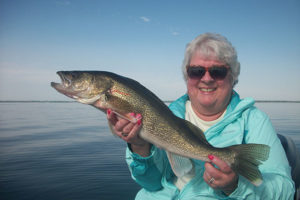 The common thought process among walleye anglers is that shallow walleye are spooky and require stealth tactics. Consequently, people pursuing these early weed walleye like to spread their lines out by either weighting the bait rigs with a small split shot then trailing them far behind the boat, or, using planer boards to take them off to the side. Years of experience have taught me just the opposite. What I’ve found is shallow walleye are aggressive with one thing on their mind, eating every perch and shiner they can sink their teeth into. Walleye consistently bite rigs that are trolled just feet from the trolling motor prop and directly below the boat. I work rigs trailed behind 1 ½ ounce bottom bouncers at trolling speeds around 1.1 mph. This keeps the lines running nearly vertical and easily worked just over the weed tops. Release just enough line to keep the bouncer about one foot above the weed tops. Short leader lengths of 2-3 feet keep the baits from constantly fouling in the weeds. Using nine foot trolling rods and Abu Garcia Alphamar linecounter reels spooled with 10 lb Trilene Sensation monofilament allows enough give when a big fish hits with less than ten feet of line out.
The common thought process among walleye anglers is that shallow walleye are spooky and require stealth tactics. Consequently, people pursuing these early weed walleye like to spread their lines out by either weighting the bait rigs with a small split shot then trailing them far behind the boat, or, using planer boards to take them off to the side. Years of experience have taught me just the opposite. What I’ve found is shallow walleye are aggressive with one thing on their mind, eating every perch and shiner they can sink their teeth into. Walleye consistently bite rigs that are trolled just feet from the trolling motor prop and directly below the boat. I work rigs trailed behind 1 ½ ounce bottom bouncers at trolling speeds around 1.1 mph. This keeps the lines running nearly vertical and easily worked just over the weed tops. Release just enough line to keep the bouncer about one foot above the weed tops. Short leader lengths of 2-3 feet keep the baits from constantly fouling in the weeds. Using nine foot trolling rods and Abu Garcia Alphamar linecounter reels spooled with 10 lb Trilene Sensation monofilament allows enough give when a big fish hits with less than ten feet of line out.
Boredom brings innovation
While guiding I don’t fish much as I don’t want to catch a nice fish that one of my clients might have a chance of catching. A few years back a couple of clients and I were working this weed pattern and catching some nice ‘eyes. Earlier in the day we had been drifting deeper water with ¼ oz jigs tipped with 4” Gulp Alive minnows. Out of curiosity, or boredom maybe as I wasn’t handling any of the bait rods, I picked up one of the jig rods and flipped the jig behind the boat. After the jig hit bottom I popped it up with a small snap of the rod, typical snap jigging motion. I repeated this popping motion a few times before the jig would no longer reach bottom between snaps and then released some more line so the jig could hit bottom. This time after engaging the reel I snapped the rod hard causing the jig to really shoot forward and up. After a couple of these hard snaps the rod loaded up under the weight of a nice walleye. For the rest of the trip my clients jigged up numerous walleye, stopping only long enough to reel in a fish on one of the bait rods that had been placed in rod holders. This combination of rigging and “power snap” jigging has put hundreds and hundreds of walleye in the net for my clients.
Perfecting the pattern
These active, hunting, walleye work the bait in two different ways. The bait fish are using the new weed growth as cover, much like a deer will use a timber draw or grove of trees, to hide from predators. First the walleye, just like a pack of wolves push through the cover spooking deer, will push through a small weed patch causing the bait to panic and flush from the cover. It’s here in the weeds where the bait rigs shine as the walleye are focused on targets that are trying to remain hidden. Once out in the open the bait stands little chance of escaping the bigger and faster predator. It’s here that the jigs really grab the walleye’s attention. Each time a jig is snapped it shoots forward 5, 10, maybe even 15 feet, depending on the veracity of the jigging motion. This power snap jigging creates the perfect illusion of a perch or shiner, in a burst of speed fleeing for its life, then tumbling slowly to the bottom in hopes of remaining hidden. It’s on the fall the walleye pounce with vicious strikes. But that doesn’t mean all bites will feel like rod-jarring hits. A walleye in hot pursuit charges from behind, overtaking and engulfing the jig just as it begins to fall. This type of bite will actually cause the line to go momentarily slack and can be seen if an angler pays attention. That’s why I use 10# HiVis Flame Green FireLine when working this pattern as it helps to show these “knock forward” bites. Truth be told though, most of the time we simply set the hook the next time we go to snap the jig forward. To the FireLine I splice a 5-6 foot leader of 10# fluorocarbon as this helps absorb a little shock on the hookset, and also helps, somewhat, with bite offs from pike. All of this is rigged on a 6’ 3” Fenwick Elite Tech MF action rod and Plueger President 6925 spinning reel. It’s important to have a light rod/reel combination that a person can snap all day without getting tired. Rare is the time when a subtle jigging motions draw more strikes. It’s that quick burst of speed and the change of direction from fall to shoot forward and back to fall that triggers the killer instinct in these big walleyes. The medium action and fast tip seem to give the ¼ oz. jig just the right amount of forward scoot when snapped hard at the 1.1 mph speed the boat is traveling.
The first thing I do each spring when I feel it’s time for this pattern to start producing is cruise a flat looking for new weed growth. Using both the 2D sonar and the SideImaging feature on my Humminbird 999 I store a waypoint for each weed patch that shows. I’m also looking for baitfish and walleye that show themselves. Next I load a course into the IPilot link system so I efficiently troll from one weed patch to the next. Now I can concentrate solely on keeping the bait rods running clean and netting fish for my clients as they snap their way to a day of fun and big walleyes.
Editor’s note: Doug Burns operates The Iowa Guide service on The Iowa Great Lakes. Find him @ www.fishnfunokoboji.com or on Facebook @ The Iowa Guide service. By phone @ 712-209-4286.

